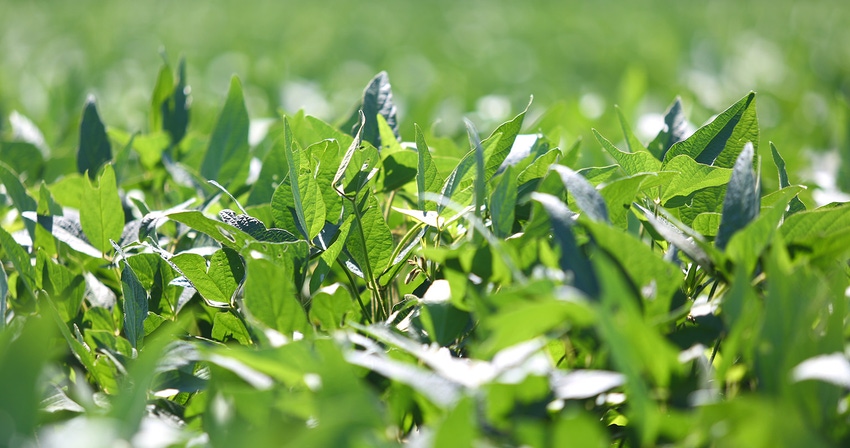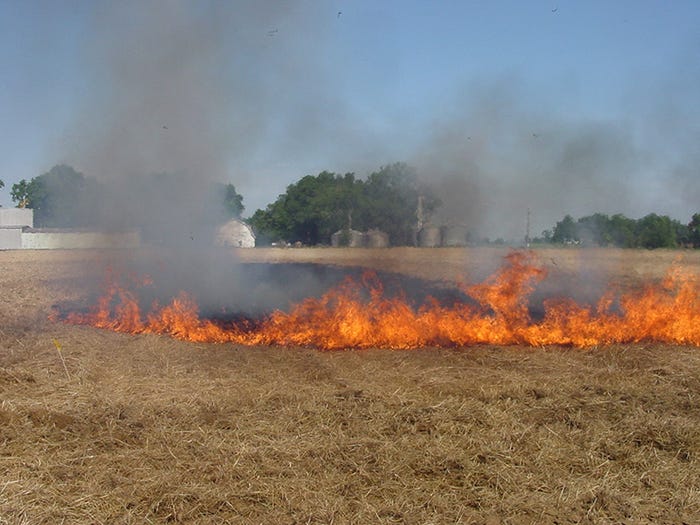September 14, 2022

Just because microbes work faster in the heat and humidity of the South does not necessarily mean farmers in Arkansas cannot take advantage of them to help sequester carbon from crop residue and build soil health over time.
Soil scientists with the Arkansas Agricultural Experiment Station say the common Arkansas practice of burning crop residue after the harvest means lost nitrogen and sulfur, displaced phosphorus and potassium, and less crop residue as food for bacteria and fungi that help build soil aggregates and create slow-release nutrients.
 Kristofor Brye uses a slide hammer and core chamber to collect a soil sample in a soybean plot. (Fred Miller, U of A System Division of Ag)
Kristofor Brye uses a slide hammer and core chamber to collect a soil sample in a soybean plot. (Fred Miller, U of A System Division of Ag)
Burning crop residue provides short-term benefits for weed control and preparing the seedbed for planting but has been found to have no long-term benefits, according to Kristofor Brye, University Professor of applied soil physics and pedology with the Arkansas Agricultural Experiment Station, the research arm of the University of Arkansas System Division of Agriculture.
There are challenges to the practice, but he says over 20 years of research, including a continuous 18-year field study, show that keeping the carbon (residue) on the field has multiple benefits.
Brye’s studies show that increasing soil organic matter and total carbon over time has the potential to improve soil quality and maintain long-term productivity of silt-loam soils in the Mississippi River Delta region.
According to Trenton Roberts, professor of soil fertility and testing for the experiment station and a soil specialist for the Cooperative Extension Service, building soil health through carbon is more difficult in the South compared to the North. He said microbes eat the crop residue as a food source and are more active in the South over the winter because the ground rarely freezes, leaving more time for them to decompose carbon-carrying organic matter.
Carbon for soil aggregation
Carbon and organic matter are critical to soil aggregation, or when soil particles clump together to create spaces in the soil for organisms to thrive. They work as a sponge-like medium for holding moisture. Soils that have stable aggregates are less prone to erosion and can maintain greater levels of soil organic matter and total carbon, by physical protection, due to the decreased erosion, Brye explained.
“The key is to make sure you have proper residue management,” Brye said. “Residue is often viewed as a nuisance. Many people want to get rid of it quickly to plant their next crop. However, we can do better than that. With proper residue management, you are putting carbon into the soil.”
 Wheat stubble is burned in a test plot at the Lon Mann Cotton Research Station in Marianna as part of a long-term study by Kristofor Brye, University Professor of applied soil physics and pedology. (U of A System Division of Ag)
Wheat stubble is burned in a test plot at the Lon Mann Cotton Research Station in Marianna as part of a long-term study by Kristofor Brye, University Professor of applied soil physics and pedology. (U of A System Division of Ag)
Carbon, which plants obtain from the atmosphere through their leaves, stores energy in carbon-to-carbon bonds, Brye explained. He added that microbes in the soil need the energy stored in those bonds, which drives the microbial decomposition process.
“The plant is the mediator to get the carbon out of the atmosphere into the soil,” Brye said. “That is the microbe’s food source. They siphon off what they need for their bodily functions and maintain their existence, but then they release nutrients. That is an essential component of nutrient cycling in soils.”
Brye said that organisms not considered primary decomposers take advantage of the additional nutrients available for consumption and make them available for plants to take up. Some of those nutrients, however, can also be susceptible to leaching. For example, nitrogen can be converted to nitrate and leach or be denitrified and float off as a gas.
“The microbes are really the unsung, hidden aspect of keeping nutrient cycles going in the soil,” Brye said.
Mindset shift
It may take a mindset shift and patience but implementing conservation tillage and not burning crop residue builds soil organic matter and nutrients over time in the upper level of the soil, Brye said.
It also could save a farmer about $275 per acre. Roberts calculated nutrients in crop residue from a 200-bushel acre rice crop at current fertilizer prices to be about $85 in nitrogen, about $30 in phosphorus, about $150 in potassium, and about $10 in sulfur. A link to the accompanying article on this issue can be found at https://bit.ly/Cost-Burning-Crop-Residue.
“We have to get the carbon in the soil, and then we have got to protect it,” Brye said. “That combination will allow us to build soil carbon, sequester it and get it out of the atmosphere. Carbon dioxide is a very abundant greenhouse gas.”
Getting the plant’s carbon into the soil is a balancing act, Brye said. If the crop residue is too small, it decomposes rapidly, leading to faster leaching. If it is too big, it can take years to decompose.
Brye suggested minimal tillage to physically break up plant stalks, but not leave the soil surface bare from deep plowing.
Long-term field study
Brye conducted an 18-year field study on silt-loam soil in eastern Arkansas that wrapped up in 2020, showing impacts of not burning crop residue combined with conservation tillage compared to burning and conventional tillage practices in a wheat-soybean, double-crop production system.
Total soil nitrogen increased more over time in the no-burn treatment averaged over tillage, residue level, and soil depth. Researchers hypothesized that the greater levels of total soil nitrogen under the no-burn treatment were thought to be partially due to the cumulative effects of crop residue retention on the soil surface.
When not burned, the residue slowly contributed nitrogen to the soil as it decomposed, and mineralization occurred. Brye said these processes could not have occurred to a similar magnitude when most of the surface residue was burned.
“Without burning, organic nitrogen in the crop residue remains on the soil surface in a non-leachable form until oxidation and mineralization occur,” Brye said.
Once burned, any remaining charred residue is more easily and quickly decomposed to release nitrogen, either easily leached away or quickly taken up by plants. Brye said both of those processes could lower soil nitrogen concentrations.
The long-term field study was conducted at the experiment station’s Pine Tree Research Station near Colt in St. Francis County and the Lon Mann Cotton Research Station in Marianna in Lee County. Data was collected for three years at the Pine Tree station and for 18 years at the Lon Mann station.
Brye said that although it took a while to see positive soil health benefits with limited tillage and incorporating crop residue, they demonstrated many benefits over the long haul, including improved water-holding capacity.
As hypothesized, the results from the long-term study showed that burning crop residue lowered soil nutrient contents. By not burning the residue, soil organic matter, total nitrogen, and total carbon all increased in the top 4 inches of the soil profile.
Conventional tillage reduces plow-layer bulk density in the short term, provides a fine seedbed, and controls weeds for adequate crop growth. However, a report in 2008 after six years of the long-term study showed that conventional tillage can induce soil compaction, disrupt soil aggregate stability, and increase soil organic matter decomposition that leads to a loss of carbon as carbon dioxide.
Brye noted that he did not have mechanical problems with getting soybeans planted or seedling emergence due to the wheat residue cover. However, in some years rains prevented timely soybean planting.
“Overall, each agricultural management practice studied had both positive and negative effects on near-surface soil properties. Further research will help clarify and solidify the results of this study,” Brye conclude.
Challenges
One of the challenges for Brye in no-till test plots was weed control. He said herbicide-resistant ryegrass was one of the side effects of his no-till plots. Cover crops can aid in weed control, he noted.
Also, crop residue is a habitat for potential pathogens that may have a negative effect on the next crop. To circumvent that, Brye said, is to practice crop rotation: corn to soybean, for example, to break that pathogen cycle.
Crop rotation also stimulates diversity in crop residues that will perpetuate a diversity of organisms that create stability among beneficial and non-beneficial organisms, Brye noted.
While there may be challenges and some potential negative effects from conservation tillage, Brye said microbes will settle into the new situation after several cropping cycles and provide “a cascade of positive benefits” such as better nutrient cycling, less fertilizer demands and improved water infiltration.
Source: University of Arkansas System Division of Agriculture, which is solely responsible for the information provided and is wholly owned by the source. Informa Business Media and all its subsidiaries are not responsible for any of the content contained in this information asset.
You May Also Like




